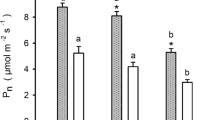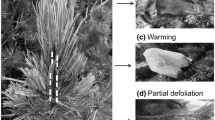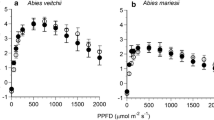Abstract
As one of the three major five-leaved pines in the northern hemisphere, Pinus koraiensis is the most important dominant tree species in the natural mixed-broadleaved Korean pine forests. However, the regeneration of P. koraiensis under the canopy of secondary forest stands is poor because of the light limitation. This study was conducted to understand how P. koraiensis seedlings adapt to different light intensities and what would be the optimum light level for their establishment and growth. Three repetition plots with four light intensities (15%, 30%, 60% and 100% of the natural incident irradiances, achieved by suspending layers of black nylon net above and surrounding the plots) were set up under natural climate conditions in a montane region in eastern Liaoning Province, Northeast China. A total of 80 P. koraiensis seedlings with similar height and root collar diameter were transplanted into four plots. After one year of acclimation to the specific light conditions, the seasonal variations of the photosynthetic variables and needle traits of the current and one-year-old needles, and the growth parameters were observed under four light intensities. The results indicated that: (1) The seedling at 60% treatment exhibited the greatest growth, which agreed with the response of the light-saturated photosynthetic rates (A max) and the dark respiration rate (R d) in the current and one-year-old needles, i.e., R d at 60% treatment was significantly lower than that at 100% treatment, but A max did not differ between the seedlings at 100% and 60% treatments. (2) The P. koraiensis seedlings have a certain photosynthetic plasticity to adapt the light conditions by adjusting their needle traits and regulating the physiological processes, because A max, R d, light saturation point and compensation point, the needle mass area, needle nitrogen and chlorophyll contents were significantly (p<0.05) correlated with the light intensities. Especially, A max at 100% and 60% treatments was significantly higher (p<0.05) than that at 30% and 15% treatments for both current and one-year-old needles. (3) The needles of different ages played a commutative role during the growing season, i.e., the one-year-old needles played a major role for the photosynthesis in the early growing season; the current year needles did in the later growing season. This ensured the effective photosynthesis throughout the growing season. These findings suggest that P. koraiensis is the in-between heliophilous and shade-tolerant tree species at least for the seedlings up to 8 years.
Similar content being viewed by others
References
Barnes BV, Xu ZB, Zhao SD. 1992. Forest ecosystems in an old-growth pine-mixed hardwood forest of Changbai Shan Preserve in northeastern China. Canadian Journal of Forest Research, 22: 144–160.
Bloor JMG, Grubb PJ. 2003. Growth and mortality in high and low light: trends among 15 shade-tolerant tropical rain forest tree species. Journal of Ecology, 91: 77–85.
Boardman NK. 1977. Comparative photosynthesis of sun and shade plants. Annual Review Plant Physiology, 28: 355–377.
Bond BJ, Farnsworth BT, Coulombe RA, Winner WE. 1999. Foliage physiology and biochemistry in response to light gradients in conifers with varying shade tolerance. Oecologia, 120: 183–192.
Chen XW, Zhou GS, Zhang XS. 2002. Spatial characteristics and change for tree species along the North East China Transect (NECT). Plant Ecology, 164: 65–74.
Choi DS, Kayama M, Jin HO, Lee CH, Izuta T, Koike T. 2006. Growth and photosynthetic responses of two pine species (Pinus koraiensis and Pinus rigida) in a polluted industrial region in Korea. Environmental Pollution, 139: 421–432.
Díaz-Barradas MC, Zunzunegui M, Ain-Lhout F, Jáuregui J, Boutaleb S, Álvarez-Cansino L, Esquivias MP. 2010. Seasonal physiological responses of Argania spinosa tree from Mediterranean to semi-arid climate. Plant and Soil, 337: 217–231.
Farquhar GD, Sharkey TD. 1982. Stomatal conductance and photosynthesis. Annual Review of Plant Physiology, 33: 317–345.
Grassi G, Bagnaresi U. 2001. Foliar morphological and physiological plasticity in Picea abies and Abies alba saplings along a natural light gradient. Tree Physiology, 21: 959–967.
Griffin JJ, Ranney TG, Pharr DM. 2004. Photosynthesis, chlorophyll fluorescence, and carbohydrate content of Illicium taxa grown under varied irradiance. Journal of the American Society for Horticultural Science, 129: 46–53.
Hieke S, Menzel CM, Ludders P. 2002. Effect of leaf, shoot and fruit development on photosynthesis of lychee trees (Litchi chinensis). Tree Physiology, 22: 955–961.
Kayama M, Sasa K, Koike T. 2002. Needle life span, photosynthetic rate and nutrient concentration of Picea glehnii, P. jezoensis and P. abies planted on serpentine soil in northern Japan. Tree Physiology, 22: 707–716.
Kubiske ME, Pregitzer KS. 1996. Effects of elevated CO2 and light availability on the photosynthetic light response of trees of contrasting shade tolerance. Tree Physiology, 16: 351–358.
Li WH. 2004. Degradation and restoration of forest ecosystems in China. Forest Ecology and Management, 201: 33–41.
Li YB, Mou P, Wang TM, Ge JP 2012. Evaluation of regeneration potential of Pinus koraiensis in mixed pine-hardwood forests in the Xiao Xing’an Mountains, China. Journal of Forestry Research, 23: 543–551.
Liu SR, Li XM, Niu LM. 1998. The degradation of soil fertility in pure larch plantations in the northeastern part of China. Ecology Engineering, 10: 75–86.
Luoma S. 1997. Geographical pattern in photosynthetic light response of Pinus sylvestris in Europe. Functional Ecology, 11: 273–281.
Ma JL, Zhuang LW, Chen D. 1992. Geographic distribution of Pinus koraiensis in the world. Journal of Northeast Forestry University, 20(5): 40–48 (in Chinese with English abstract)
Major JE, Mosseler A, Barsi DC, Corriveau-Dupuis B, Campbell M. 2009. Impact of three silvicultural treatments on growth, light-energy processing, and related needle-level adaptive traits of Pinus strobus from two regions. Forest Ecology and Management, 257: 168–181.
Mason WL, Edwards C, Hale SE. 2004. Survival and early seedling growth of conifers with different shade tolerance in a Sitka spruce spacing trial and relationship to understory light climate. Silva Fennica, 38(4): 357–370.
Messier C, Puttonen P. 1995. Spatial and temporal variation in the light environment of developing Scots pine stands: the basis for a quick and efficient method of characterizing light. Canadian Journal of Forest Research, 25: 343–354.
Modrý M, Hubený D, Rejšek K. 2004. Differential response of naturally regenerated European shade tolerant tree species to soil type and light availability. Forest Ecology and Management, 188: 185–195.
Mudrik VA, Vil’chek GE. 2001. Ecophysiological responses of Larix sibirica Ledeb. and Pinus sibirica Du Tour undergrowth to climate change. Russian Journal of Ecology, 32: 243–248.
Pastur GM, Lencinas MV, Peri PL. 2007. Photosynthetic plasticity of Nothofagus pumilio seedlings to light intensity and soil moisture. Forest Ecology and Management, 243: 274–282.
Pothier D, Prévost M. 2002. Photosynthetic light response and growth analysis of competitive regeneration after partial cutting in a boreal mixed stand. Trees, 16: 365–373.
Tao DL, Jin YH, Du YJ. 1988. Novel photosynthesis-light curves of solar-exposed versus shaded Korean pine seedling. Environmental and Experimental Botany, 28: 301–305.
Wang WJ, Zu YG, Wang HM, Matsuura Y, Sasa K, Koike T. 2006. Newly-formed photosynthates and the respiration rate of girdled stems of Korean pine (Pinus koraiensis Sieb. et Zucc.). Photosynthetica, 44: 147–150.
Wu YG, Han JX. 1992. Analysis on the structure of Korean Pine population and its natural regeneration patterns. In: Wang, Z., Li, W.H. (eds), Research of forest ecosystem. Beijing: Chinese Forestry Press, pp 14–23. (in Chinese)
Yao Y, Yang SH, Cao J. 1980. The effect of light intensity on the growth and some physiological activities of Korean Pine. In: Wang, Z., Li, W.H. (eds), Research of forest ecosystem. Beijing: Chinese Forestry Press, pp 43–50. (in Chinese)
Zhao GY, Hao AJ, Yang CT. 1991. Determination about the Northwestern area limit of Pinus koraiensis and the geographical occurrence of Pinus sibirica. Journal of Northeast Forestry University, 2: 42–46. (in Chinese with English abstract)
Zhang M, Zhu JJ, Li MC, Zhang GQ, Yan QL, 2013. Different light acclimation strategies of two coexisting tree species seedlings in a temperate secondary forest along five natural light levels. Forest Ecology and Management, 306: 234–242
Zhu JJ, Mao ZH, Hu LL, Zhang, JX. 2007. Plant diversity of secondary forests in response to anthropogenic disturbance levels in montane regions of northeastern China. Journal of Forest Research, 12: 403–416.
Zhu JJ, Matsuzaki T, Li FQ, Gonda Y. 2003. Effect of gap size created by thinning on seedling emergency, survival and establishment in a coastal pine forest. Forest Ecology and Management, 182: 339–354.
Author information
Authors and Affiliations
Corresponding author
Additional information
Fund projection: This research was supported by a grant from the National Nature Science Foundation of China (30830085, 31330016).
Rights and permissions
About this article
Cite this article
Zhu, J., Wang, K., Sun, Y. et al. Response of Pinus koraiensis seedling growth to different light conditions based on the assessment of photosynthesis in current and one-year-old needles. Journal of Forestry Research 25, 53–62 (2014). https://doi.org/10.1007/s11676-014-0432-7
Received:
Accepted:
Published:
Issue Date:
DOI: https://doi.org/10.1007/s11676-014-0432-7




